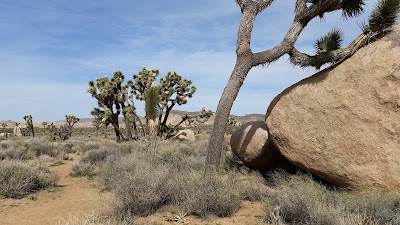We started our visit by hiking at Cottonwood Spring, originally
inhabited by Cahuilla Indians, who lived off the vegetation of these
lands. You can still see remnants of
their pottery and holes in rocks where they ground/pulverized mesquite beans
(part of the pea family) into flour. The
fan palm trees are enormous here, with trunks more than three feet in diameter! And the yuccas are all in various stages of
bloom.
 |
Fan Palm Trees |
 |
A yucca in bloom |
 |
This yucca hasn't opened up yet |
Look, up on that rock—it’s a chuckwalla sunbathing! That’s one huge lizard! His patches of copper and sand coloring make
him blend in so well with the rock formations.
 |
This is "Actual Size"! No Zoom Lens Here! |
As we traverse further down the road, the rock formations,
terrain, and plant life change—evidence we entered the portion of the park that
lies within the Mojave Desert. Here’s
where the actual Joshua trees live!
While the four “geezers” take a lunch break, I hike and play
among the boulders whose visual characteristics lend to the name "Split Rock."
 |
Rambling RV Rat at Split Rock |
We hike some more after lunch, taking in Barker Dam, built
circa 1900 to hold water for cattle and mining use, and Hidden Valley, a
legendary cattle rustlers’ hideout. Here
folks are rock climbing. I want to join
them, but my Mom put the kibosh on my adventurous plan. Instead I watch a couple of romantic lizards
giving me a lesson on “the birds and bees”.
From Keys View, at an elevation of 5,185 feet, we could see
Desert Palms, Palm Springs, even the San Andreas Fault.
There is so much more to see here at Joshua Tree National Park. Although we saw signs of wildlife, including poop, footprints, and holes, we didn’t get any photo ops. And I still haven’t seen a desert tortoise! But alas, dusk is upon us and the park will be closing. Time to return to Quartzsite. It sure was a fun day!
















Great pics! There sure are some great hikes in Joshua.
ReplyDelete